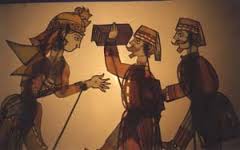China’s Ancient Art of Shadow Puppetry
Shadow play, also known as shadow puppetry is an ancient form of storytelling which uses flat figures (shadow puppets) to create cut-out figures which are held between a source of light and a translucent screen or scrim. Or, sometimes shadow play can refer to various positions of the hand to create certain “figures” appear with intricate and creative hand posturing. Various effects can be achieved by moving both the puppets and the light source. A talented puppeteer can make the figures appear to walk, dance, fight, nod and laugh. Shadow puppetry has a long history in Asia and is a popular form of entertainment for both children and adults.
Legend attributes the origin of shadow puppets to 121 BC during the time of Wu-ti, an emperor of the Han dynasty. When his favorite concubine died, he was devastated and summoned his court officers to bring his beloved back to life. The officers made a shape of the concubine using donkey leather. Her joints were
animated using 11 separate pieces of the leather, and adorned with painted clothes. Using an oil lamp they made her shadow move, bringing her back to life and the Emperor was satisfied. Whatever the origin of puppetry, it is fairly certain that itinerant puppeteers from China took it to Korea and throughout Asia.
During the Ming Dynasty there were 40 to 50 shadow show troupes in the city of Beijing alone. The earliest shadow theatre screens were made of mulberry paper. The storytellers generally used the art to tell events happening between various warring kingdoms. The prototype of shadow puppets is paper cut by scissors, and later it was changed to leather engraving. In China 2000 years ago, it was known as the “theatre of the lantern shadows”. More recently, it has been called “the father of film”. Shadow puppetry was ushered to the West around the thirteenth century, and still retains its original character, and it is even called a "National Treasure.
Sources: Ancientworld.com; David Taylor; Wikipedia and Wikimedia



